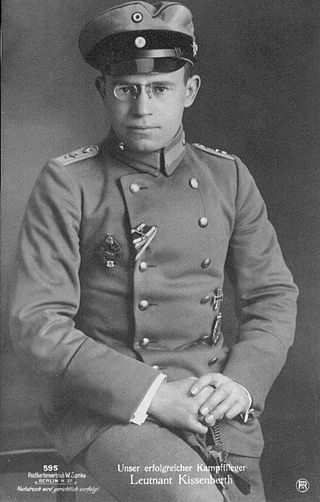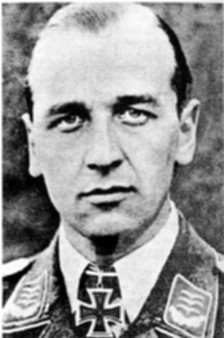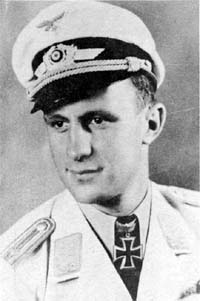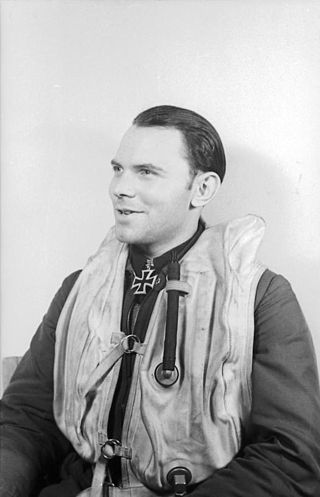
A flying ace, fighter ace or air ace is a military aviator credited with shooting down five or more enemy aircraft during aerial combat. The exact number of aerial victories required to officially qualify as an ace is varied, but is usually considered to be five or more.

Hauptmann Wilhelm "Willi" Reinhard was a German pilot during World War I. Reinhard became a flying ace during the war, credited with 20 confirmed aerial victories. After commanding two successive fighter squadrons, he was picked to replace Manfred von Richthofen as commander of Jagdgeschwader 1 when the Red Baron fell in combat. Reinhard died on 3 July 1918 while testing a prototype fighter.

Otto Kissenberth was a German flying ace of World War I credited with 20 aerial victories. He was a prewar mechanical engineer who joined the German air service in 1914. After being trained and after serving as a reconnaissance pilot, he became one of the first German fighter pilots, flying with Kampfeinsitzerkommando KEK Einsisheim. He scored six victories with this unit as it morphed into a fighter squadron, Jagdstaffel 16. His success brought him command of Jagdstaffel 23 on 4 August 1917. He would run his victory tally to 20, downing his final victim using a captured British Sopwith Camel on 20 May 1918. Nine days later, a crash while flying the Camel ended Kissenberth's combat career. His injuries were severe enough he was not returned to combat, instead being assigned to command Schleissheim's flying school. Although Otto Kissenberth survived the war, he died soon after in a mountaineering accident on 2 August 1919.

Werner Streib was a German Luftwaffe military aviator during World War II, a night fighter ace credited with 68—one daytime and 67 nighttime—enemy aircraft shot down in about 150 combat missions. All of his nocturnal victories were claimed over the Western Front in Defense of the Reich missions against the Royal Air Force's Bomber Command.

Hans-Heinz Augenstein was a German Luftwaffe military aviator and flying ace during World War II. A flying ace or fighter ace is a military aviator credited with shooting down five or more enemy aircraft during aerial combat. Operating as a night fighter pilot, he was credited with 46 aerial victories, of which 45 were four-engine bombers, all of which claimed in Defense of the Reich.

Air vice-marshal Sir Francis John Williamson Mellersh, was a Royal Naval Air Service aviator and flying ace credited with five aerial victories during the First World War, and a senior commander in the Royal Air Force during the 1940s and 1950s. He was killed in a helicopter accident in 1955.
Flight Commander Frederick Carr Armstrong was a Canadian First World War flying ace, officially credited with 13 aerial victories.
Lieutenant Alfred Victor Blenkiron was a British World War I flying ace credited with five aerial victories.
Joseph Cruess Callaghan, was an Irish flying ace of the First World War, credited with five aerial victories.
LeutnantWalter Böning was a German World War I flying ace from the Grand Duchy of Oldenburg credited with 17 aerial victories. He began his World War I military service as an infantryman. He distinguished himself by winning both the Gold Medal for Bravery and the Second Class Iron Cross. He then transferred to aviation duty, training originally as a reconnaissance pilot before advancing to become a fighter pilot. Between 6 April 1917 and 30 May 1918, he was credited with 17 aerial victories. On 31 May 1918, he survived a midair collision while being attacked by British fighters. Although he coaxed his damaged machine home, the serious leg wound he had suffered sidelined him through war's end.
Captain Geoffrey Herbert Hooper was an Australian World War I flying ace credited with eleven aerial victories, all against German fighter planes.

Sophus Baagoe was a German fighter pilot in the Luftwaffe and fought during World War II. Baagoe was credited with fourteen aerial victories, making him a fighter ace. A fighter ace is a military aviator credited with shooting down five or more enemy aircraft during aerial combat.

Paul Gildner was a German Luftwaffe military aviator during World War II, a night fighter ace credited with 44 aerial victories, including two by day, claimed in approximately 160 combat missions making him one of the more successful night fighter pilots in the Luftwaffe. All of his victories were claimed over the Western Front in Defense of the Reich missions against the Royal Air Force's (RAF) Bomber Command.

Heinz Vinke was a German Luftwaffe military aviator during World War II, a night fighter ace credited with 54 aerial victories claimed in approximately 150 combat missions making him the eighteenth most successful night fighter pilot in the history of aerial warfare. All of his victories were claimed over the Western Front in Defense of the Reich missions against the Royal Air Force's (RAF) Bomber Command.
Helmut Bergmann was a German Luftwaffe military aviator during World War II, a night fighter ace credited with 36 enemy aircraft shot down in 135 combat missions. All of his victories were claimed over the Western Front in nocturnal Defense of the Reich missions against the Royal Air Force's Bomber Command.

August Geiger was a German Luftwaffe military aviator during World War II, a night fighter ace credited with 53 aerial victories making him the nineteenth most successful night fighter pilot in the history of aerial warfare. All of his victories were claimed over the Western Front in Defense of the Reich missions, the majority at night against the Royal Air Force's (RAF) Bomber Command and one daytime claim over a United States Army Air Forces (USAAF) Boeing B-17 Flying Fortress.

During World War I, the national air services involved developed their own methods of assessing and assigning credit for aerial victories.

Gerald Richard Johnson was a World War II flying ace who flew for the United States Army Air Forces. Johnson commanded the 9th Fighter Squadron and 49th Fighter Group, and became the fourth ranking fighter ace in the Pacific during World War II. He ended his war career with 22 kills.

Hugo Throssell Armstrong was an Australian flying ace of the Royal Australian Air Force (RAAF) during the Second World War. He was credited with at least ten aerial victories.












